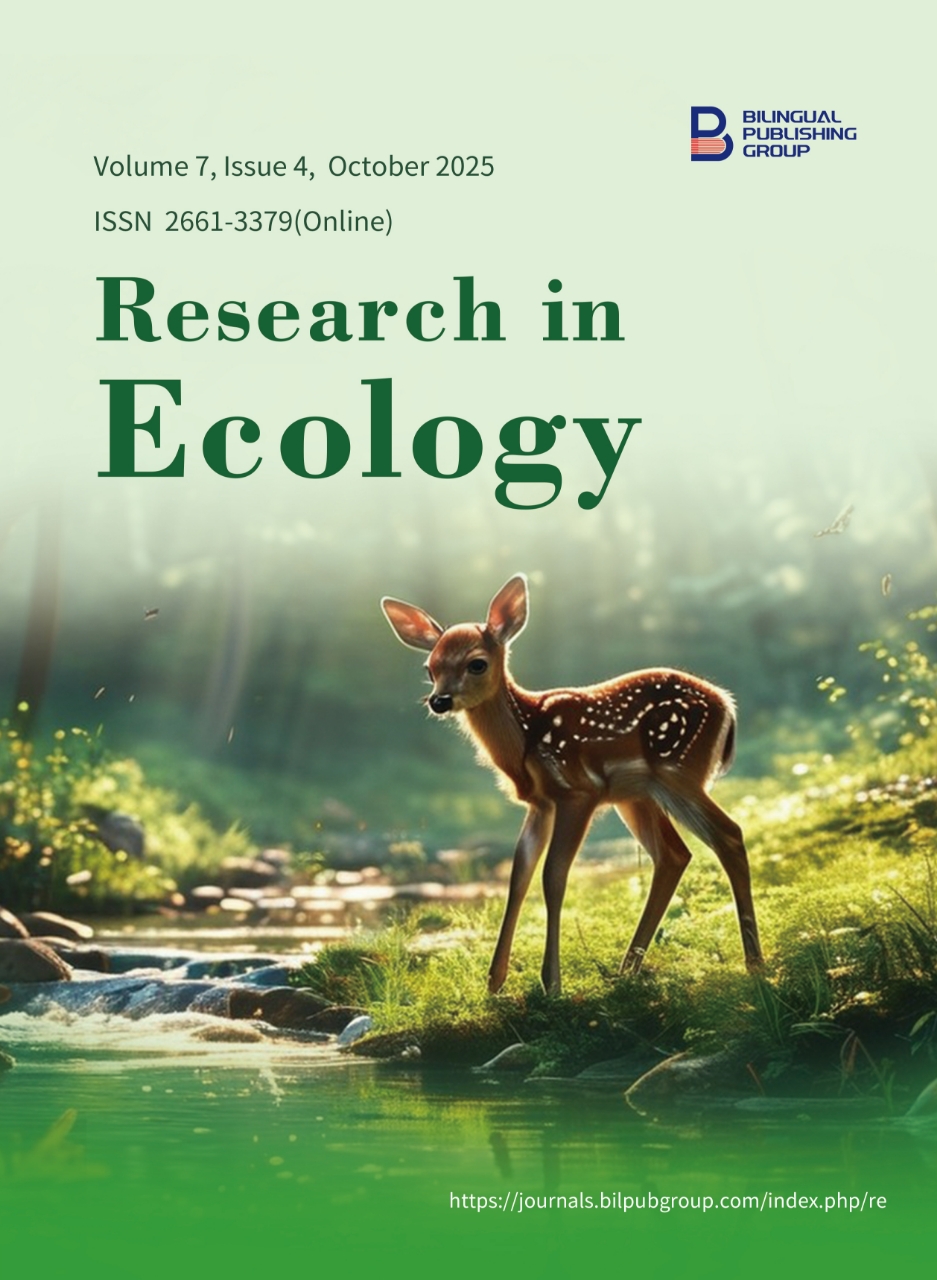
Optimizing Field Taxonomy: Development of a Field-Adapted Identification Key to the Rodents of an Afromontane Tropical Rainforest
DOI:
https://doi.org/10.30564/re.v7i4.10304Abstract
Identification keys for terrestrial small mammals are often based on scientific details that require close examination of museum specimens. This paper builds on external morphological characteristics of the rodents recorded through live trapping from 2011 to 2023 in Nyungwe National Park, a tropical rainforest in Rwanda, to formulate a taxonomic key suitable for both expert and non-expert researchers working in similar ecosystems across Africa. We reviewed the literature on taxonomic keys and field guide documents for small mammals to assess their practicality and identify gaps, with a special focus on their relevance to tropical regions and our study area. We then integrated our field records to harmonize this new development. We describe 23 rodent species, identified and confirmed using advanced taxonomic techniques, including DNA barcoding and voucher specimens. The study emphasizes that external features—particularly field photographs, body coloration (dorsal, ventral, and lateral views), and other distinctive anatomical traits—can serve as an effective field taxonomic key for rodents and other terrestrial small mammals, accessible to a broad scientific community. The paper also discusses the limitations of traditional dichotomous keys compared to short descriptions paired with photographic illustrations. The resulting key can be used as a template and is open to refinement as additional species are confirmed, re-assessed, or validated through advanced tools. Future studies may adapt this approach for other terrestrial small mammals and different locations across African tropical rainforests.
Keywords:
External Character; Fur Color; Identification; Nyungwe; Rodents; Tropical ForestReferences
[1] Barnett, A., Dutton, J., 1995. Expedition field techniques: Small mammals (excluding bats). Royal Geographical Society with IBG: London, UK. pp. 1–126. DOI: https://doi.org/10.5962/p.384319
[2] Bennun, L., Davies, G., Howell, K., et al., 2004. African forest biodiversity: A field survey manual for vertebrates. Earthwatch Institute: Oxford, UK. pp. 1–161. Available from: https://archive.org/details/africanforestbio0000unse
[3] Newbery, C.H., 1999. A key to the Soricidae, Macroscelididae, Gliridae and Muridae of Gauteng, North West Province, Mpumalanga and the Northern Province, South Africa. Koedoe. 42(1), 51–55. DOI: https://doi.org/10.4102/koedoe.v42i1.221
[4] Teta, P., Jayat, J.P., 2021. Identification keys to murid rodents of Argentina. Therya. 12(3), 501–526.
[5] Nagorsen, D.W., 2002. An identification manual to the small mammals of British Columbia. Royal British Columbia Museum: Victoria, BC, Canada. pp. 1–153. Available from: https://www.crownpub.bc.ca/Product/Details/7680001900_S
[6] Herbreteau, V., Jittapalapong, S., Rerkamnuaychoke, W., et al. (Eds.), 2012. Protocols for field and laboratory rodent studies. Kasetsart University: Bangkok, Thailand. pp. 1–46. Available from: https://ird.hal.science/ird-00714514v1
[7] Pimsai, U., Pearch, M.J., Satasook, C., et al., 2014. Murine rodents (Rodentia: Murinae) of the Myanmar-Thai-Malaysian peninsula and Singapore: Taxonomy, distribution, ecology, conservation status, and illustrated identification keys. Bonn Zoological Bulletin. 63(1), 15–114. Available from: https://biostor.org/reference/151451
[8] Frey, J.K., 2007. Key to the rodents of New Mexico: Final report submitted to Conservation Services Division. Department of Game and Fish: New Mexico. pp. 1–120.
[9] Griffin, M., 1990. A review of taxonomy and ecology of gerbilline rodents of the Central Namib Desert, with keys to the species (Rodentia: Muridae). In: Seely, M.K. (Ed.), Namib ecology: 25 years of Namib research. Transvaal Museum Monograph No.7. Transvaal Museum: Pretoria, South Africa. pp. 83–98.
[10] Delany, M.J., 1975. The rodents of Uganda. Trustees of the British Museum (Natural History): London, UK. pp. 1–165.
[11] Godinez, E.G., Guerrero, S., 2014. The rodents from Jalisco, Mexico: Identification key. Therya. 5(2), 633–678.
[12] Lunde, D., Son, N.T., 2001. An identification guide to the rodents of Vietnam. American Museum of Natural History: New York, NY, USA. pp. 1–80. Available from: https://www.amnh.org/content/download/36262/537953/file/an-identification-guide-to-the-rodents-of-vietnam.pdf
[13] Thorn, E., Kerbis Peterhans, J.C., 2009. Small mammals of Uganda: Bats, shrews, hedgehog, golden-moles, otter-tenrec, elephant-shrews, and hares. Bonner Zoologische Monographien. 55, 1–164. Available from: https://zoologicalbulletin.de/BzB_Volumes/BzM_55/BZM_55_small.pdf
[14] Meester, J., 1953. The genera of African shrews. Annals of the Transvaal Museum. 22, 205–214. Available from: https://journals.co.za/doi/pdf/10.10520/AJA00411752_382
[15] Denys, C., Jacquet, F., Kadjo, B., et al., 2021. Shrews (Mammalia, Eulipotyphla) from a biodiversity hotspot, Mount Nimba (West Africa), with a field identification key to species. Zoosystema. 43(30), 729–757. DOI: https://doi.org/10.5252/zoosystema2021v43a30
[16] Zuk, M., Decruyenaere, J.G., 1994. Measuring individual variation in colour: A comparison of two techniques. Biological Journal of the Linnean Society. 53(2), 165–173. DOI: https://doi.org/10.1111/j.1095-8312.1994.tb01007.x
[17] Laurance, W.F., Grant, J.D., 1994. Photographic identification of ground-nest predators in Australian tropical rainforest. Wildlife Research. 21(2), 241–248. DOI: https://doi.org/10.1071/WR9940241
[18] Amori, G., Masciola, S., Saarto, J., et al., 2012. Spatial turnover and knowledge gap of African small mammals: Using country checklists as a conservation tool. Biodiversity and Conservation. 21, 1755–1793. DOI: https://doi.org/10.1007/s10531-012-0275-5
[19] D’Elía, G., Fabre, P.-H., Lessa, E.P., 2019. Rodent systematics in an age of discovery: Recent advances and prospects. Journal of Mammalogy. 100(3), 852–871. DOI: https://doi.org/10.1093/jmammal/gyy179
[20] Tuyisingize, D., Kerbis Peterhans, J.C., Bronner, G.N., et al., 2013. Small mammal community composition in the Volcanoes National Park, Rwanda. Bonn Zoological Bulletin. 62(2), 177–185. Available from: https://archive.org/details/biostor-293872
[21] Geider, M., Kock, D., 1991. Small mammals of the fogged forest of Nyungwe, Rwanda. Natur Und Museum. 121(7), 210–216.
[22] Kerbis Peterhans, J.C., 2009. Key to the identification of small mammals collected in Nyungwe National Park. Unpublished. pp. 1–3.
[23] García-Llamas, P., Rangel, T.F., Calvo, L., et al., 2019. Linking species functional traits of terrestrial vertebrates and environmental filters: A case study in temperate mountain systems. PLoS ONE. 14(2), e0211760. DOI: https://doi.org/10.1371/journal.pone.0211760
[24] Kahle, D., Wickham, H., 2013. ggmap: Spatial Visualization with ggplot2. The R Journal. 5(1), 144–161. DOI: https://doi.org/10.32614/RJ-2013-014
[25] IUCN, 2023. World Heritage Nomination - IUCN Technical Evaluation: Nyungwe National Park (Rwanda). In IUCN Evaluations of Nominations of Natural and Mixed Properties to the World Heritage List. World Heritage Committee: Riyadh, Saudi Arabia. pp. 137–144. Available from: https://whc.unesco.org/document/199670
[26] Happold, D.C.D. (Ed.), 2013. Mammals of Africa. Volume III: Rodents, Hares and Rabbits. Bloomsbury Publishing: London, UK. pp. 1–784.
[27] Wilson, D.E., Reeder, D.M. (Eds.), 2005. Mammal species of the world: A taxonomic and geographic reference, Volume 2. The Johns Hopkins University Press: Baltimore, MD, USA. pp. 1–2142. Available from: https://www.departments.bucknell.edu/biology/resources/msw3/
[28] Upham, N., Burgin, C., Widness, J., et al., 2025. Mammal Diversity Database (Version 2.0). DOI: https://doi.org/10.5281/zenodo.15007505 (cited 11 March 2025).
[29] Mizerovská, D., Nicolas, V., Demos, T.C., et al., 2019. Genetic variation of the most abundant forest‐dwelling rodents in Central Africa (Praomys jacksoni complex): Evidence for Pleistocene refugia in both montane and lowland forests. Journal of Biogeography. 46(7), 1466–1478. DOI: https://doi.org/10.1111/jbi.13604
[30] Dowsett, R.J., Dowsett-Lemaire, F., 1990. Les mammifères de la forêt de Nyungwe (Rwanda): État des connaissances. In: Dowsett, R.J. (Ed.). Survey of the fauna and flora of Nyungwe Forest, Rwanda. Tauraco Research Report 3, Belgium. pp. 111–121. Available from: https://www.africanbirdclub.org/sites/default/files/Rwanda_Nyungwe_Forest.pdf
[31] Monadjem, A., Farooq, H., Kane, A., 2024. Elevation filters bat, rodent and shrew communities differently by morphological traits. Diversity and Distributions. 30(3), e13801. DOI: https://doi.org/10.1111/ddi.13801
[32] Verde Arregoitia, L.D., Fisher, D.O., Schweizer, M., 2017. Morphology captures diet and locomotor types in rodents. Royal Society Open Science. 4(1), 160957. DOI: https://doi.org/10.1098/rsos.160957
[33] Fourcade, Y., Alhajeri, B.H., 2025. Global phylogenetic and functional structure of rodent assemblages. Ecography. 2025(8), e07534. DOI: https://doi.org/10.1002/ecog.07534
[34] Chang, G., Zhang, Z., 2014. Functional traits determine formation of mutualism and predation interactions in seed-rodent dispersal system of a subtropical forest. Acta Oecologica. 55, 43–50. DOI: http://dx.doi.org/10.1016/j.actao.2013.11.004
[35] Oberosler, V., Tenan, S., Zipkin, E.F., et al., 2020. Poor management in protected areas is associated with lowered tropical mammal diversity. Animal Conservation. 23(2), 171–181. DOI: http://dx.doi.org/10.1111/acv.12525
Downloads
How to Cite
Issue
Article Type
License
Copyright © 2025 Methode Majyambere, Pacifique Niyodushima, Antoine Nsabimana

This is an open access article under the Creative Commons Attribution-NonCommercial 4.0 International (CC BY-NC 4.0) License.




 Methode Majyambere
Methode Majyambere






